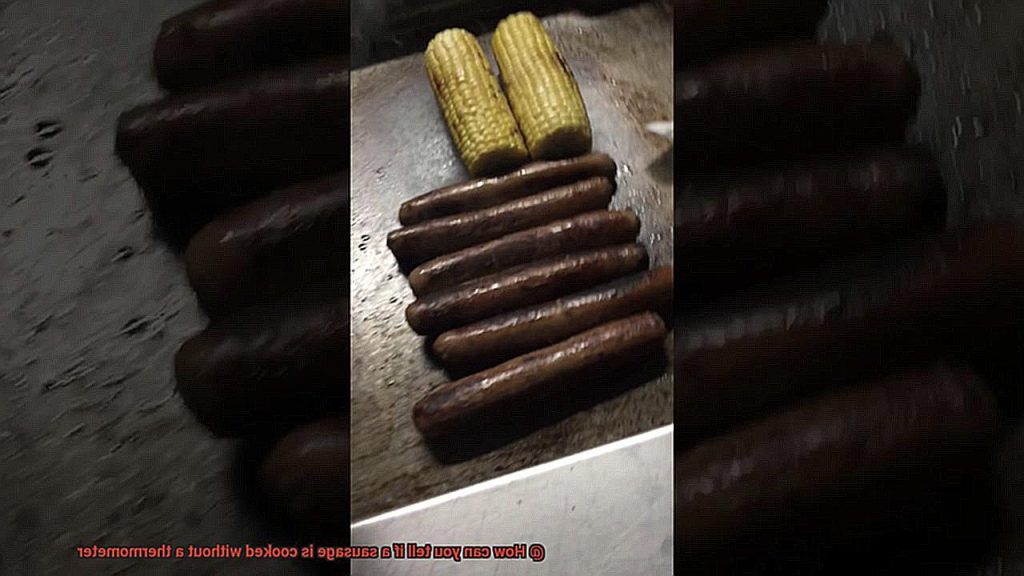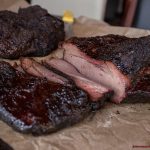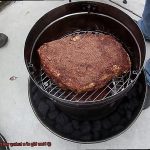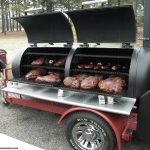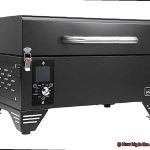Picture this: You’re standing in front of a sizzling pan of sausages, the aroma wafting up to your nose. But how do you know if they’re fully cooked? Sure, a meat thermometer would be ideal, but what if you don’t have one on hand? Fear not. Knowing how to tell if a sausage is cooked without a thermometer is an essential skill for any home cook.
Cooking sausages can seem like a daunting task, but it doesn’t have to be. With some simple techniques and sensory cues, you can ensure that your sausages are perfectly cooked every time. In this blog post, we’ll explore various ways to check for doneness using your senses – sight, touch, and sound. We’ll also share tips on selecting and storing sausages to maximize their flavor.
Whether you’re feeding a hungry crowd with breakfast sausages or grilling up some bratwursts for a summer BBQ, knowing how to gauge doneness without relying on a thermometer will make you feel like a pro in the kitchen. So join us as we dive into the world of cooking sausages to perfection – no thermometer required.
Contents
What is a Meat Thermometer and Why Do People Use It?
Achieving that ideal level of doneness can be tricky, especially if you’re not experienced in the kitchen. That’s where a meat thermometer comes in.
A meat thermometer is a handy kitchen gadget that measures the internal temperature of cooked meat. It comes in various shapes and sizes, but they all serve the same purpose – to ensure that meat is cooked to a safe temperature. The probe is inserted into the meat, and a display shows the temperature reading.
The primary reason people use meat thermometers is safety. Undercooked meat can harbor harmful bacteria like Salmonella, E.coli, and Listeria, which can cause food poisoning. By using a meat thermometer, you can ensure that your meat is cooked to the appropriate temperature, which kills any harmful bacteria present. This is especially important for meats like chicken and pork, which need to be cooked to higher temperatures than beef or lamb.
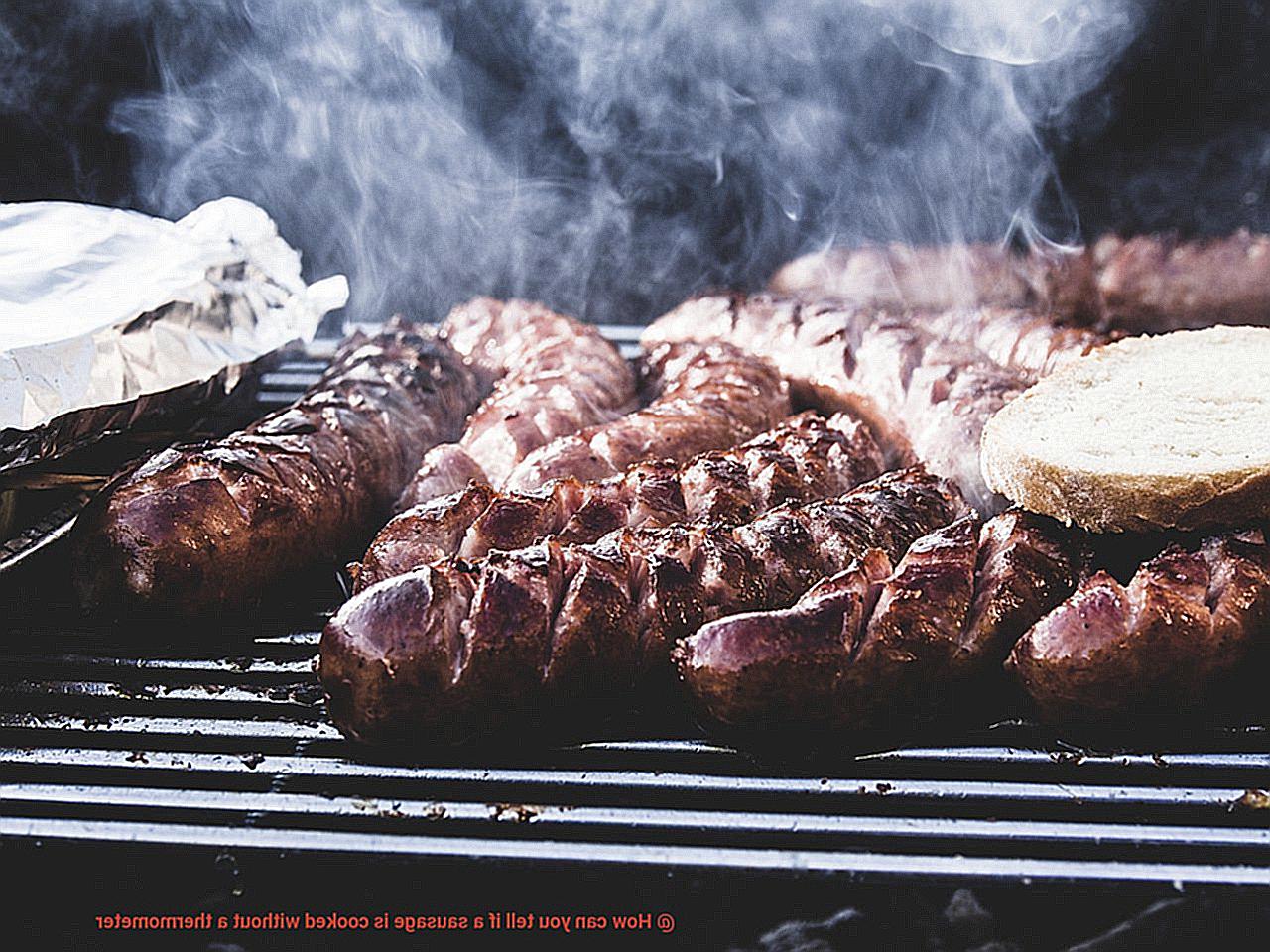
But a meat thermometer isn’t just for safety purposes. It’s also useful for ensuring that meat is cooked to the desired level of doneness. Different meats have different ideal cooking temperatures depending on their size, shape, and cut. For example, a medium-rare steak should be cooked to an internal temperature of 130-135°F, while a well-done steak should be cooked to 160°F or higher. By using a meat thermometer, you can ensure that your meat is cooked precisely as you want it.
Using a meat thermometer may seem intimidating at first, but it’s actually quite simple. Just insert the probe into the thickest part of the meat and wait for the temperature reading. It only takes a few seconds and can save you from serving undercooked or overcooked meat. Plus, some thermometers even have preset temperatures for various types of meat and levels of doneness, making it even easier to achieve the perfect cook.
How to Tell if a Sausage is Cooked Without a Thermometer
There are various ways to check if a sausage is cooked without relying on a thermometer. Here are some helpful tips:
Observing Color and Texture
One of the easiest ways to determine if your sausage is cooked is by observing its color and texture. The exterior of a cooked sausage should be an even brown color, while the interior should no longer be pink. When pressed with tongs or a fork, the sausage should feel firm to the touch. If it is mushy or soft, it may not be fully cooked.
Performing the Bounce Test
Another method of checking if your sausage is cooked is by performing the “bounce test”. Simply press your finger against the surface of the sausage. If it bounces back, then it’s likely cooked through. If it feels soft or mushy, it needs more time on the grill or in the pan.
Using a Fork or Toothpick
You can also use a fork or toothpick to pierce through the sausage. If clear juice runs out, then it’s done. But if you see pink or bloody juice, then it needs more time to cook.
Trying Different Techniques for Different Sausages
It’s important to note that different types of sausages may have different cooking times and techniques. For example, pork sausages may take longer to cook than chicken sausages because of their higher fat content. It’s always best to consult a recipe or trusted source for specific cooking instructions and times when preparing different types of sausages.
Using the Twist Test
To be extra sure that your sausage is cooked all the way through, you can use the “twist test”. Grab one end of the sausage with tongs and give it a twist. If the skin starts to crack or split, it is likely overcooked. However, if the skin remains intact and the sausage feels firm, it is likely fully cooked.
Look at the Color of the Sausage
By paying attention to the color of your sausages, you can easily tell if they’re fully cooked or not.
Here’s what to look for:
- Even brown color: A sausage that’s fully cooked should have an even brown color on both the inside and outside. If you see any pink or raw-looking areas, it needs more time on the grill.
- Type of sausage matters: Keep in mind that some sausages, like those made with turkey or chicken, may have a lighter color even when fully cooked. So instead, look for a slightly golden or caramelized appearance on the outside.
- Don’t overcook: Overcooking your sausages can lead to dry and tough meat. If you notice your sausages starting to split open or ooze juices, they’re overcooked and need to come off the grill immediately.
- Practice makes perfect: Using the color of your sausage as a guide for doneness takes some practice and attention to detail. But with experience, you’ll be able to determine the perfect cooking time for your favorite sausages without relying on a thermometer.
Check Its Texture
Checking the texture of your sausages is a crucial step to ensure they are cooked to perfection.
While an even brown color can be a visual cue, it’s not always reliable. So how can you tell if your sausage is cooked without a thermometer? By using your sense of touch and sight to check its texture.
First things first, let’s distinguish between raw and cooked sausages. Raw sausages are soft and mushy, while cooked sausages are firmer and more solid. Now that we’ve got that covered, let’s explore the different ways to check the texture.
Using tongs, gently squeeze the sausage. If it feels firm and doesn’t give much, then it is likely cooked through. On the other hand, if it still feels soft or squishy, then it needs more time on the grill. It’s that simple.
If you want to double-check, slice open the sausage. Cooked sausages should have an even color throughout with no pink or raw-looking sections. The meat should also be firm and not runny or watery. It’s worth noting that different types of sausages may have different textures when fully cooked, so it’s helpful to know what texture to look for based on the type of sausage you’re grilling.
Cut Into the Sausage to Check Internal Temperature
Cooking the perfect sausage requires precision and accuracy. One of the most common and reliable methods to check the internal temperature of the sausage is by cutting it open. This method is often used by professional chefs and home cooks because it provides a quick and easy way to assess the doneness of the sausage.
However, before grabbing your knife, exercise patience. Wait until the sausage has been cooking for at least half of its recommended cooking time before checking its internal temperature. Cutting into the sausage too early can cause dryness and loss of flavor, so it’s crucial to avoid this mistake.
When you are ready to check the temperature, use a clean knife to make a small incision in the thickest part of the meat. Gently press down on either side of the cut to expose the inside of the sausage. Observe the color and texture of the meat, as well as any juices that may come out.
The texture and color of the meat will tell you a lot about whether or not it is fully cooked. If it’s still pink or has a firm texture, it’s likely not cooked through. Sausages should be cooked until they’re uniformly browned and have a slightly softer texture. Additionally, if any juices that come out are pink or red in color, this is a sign that the sausage needs more cooking time.
Remember, cutting into the sausage too early can lead to dryness and loss of flavor. To avoid this, wait until at least half of the recommended cooking time has passed before checking its internal temperature. This way, you can ensure that your sausage remains moist and flavorful.
Considerations for Different Types of Sausages
Sausages are a versatile and popular food that can be enjoyed in a variety of ways. However, different types of sausages require different cooking methods and temperatures to ensure they are fully cooked and safe to eat. Here are five sub-sections outlining considerations for different types of sausages when determining if they are fully cooked.
Fresh Sausages
Fresh sausages, such as bratwurst or Italian sausage, are made with raw meat and must be thoroughly cooked before consumption. These sausages can be grilled, baked, boiled, or pan-fried. When cooking fresh sausages, pay attention to their color.
Once the sausage turns brown or grayish, it is cooked. Additionally, you can check for the internal temperature of the sausage by piercing it with a fork or knife. If the juices run clear, it means the sausage is cooked through.
Smoked Sausages
Smoked sausages, such as kielbasa or andouille, are pre-cooked and only require heating before consumption. They can be grilled, baked or pan-fried. To determine if a smoked sausage is cooked, use a meat thermometer to check its internal temperature. Once the temperature reaches 165°F, the sausage is ready to eat.
Cured Sausages
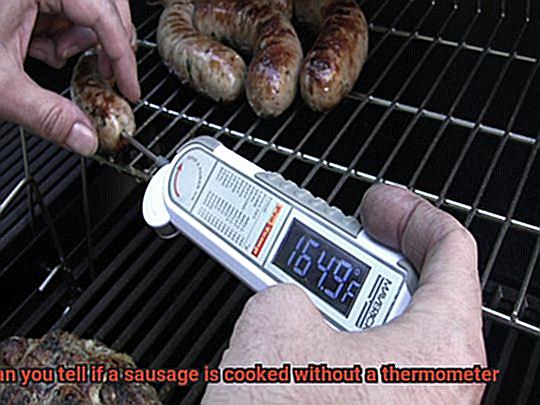
Cured sausages, such as salami or pepperoni, can be eaten raw or cooked. If you prefer to cook them, they can be grilled or pan-fried. To ensure that a cured sausage is fully cooked, check its internal temperature using a meat thermometer. Once the temperature reaches 160°F, the sausage is ready to eat.
Bratwurst
Bratwurst is a type of fresh sausage that is traditionally made with pork and requires thorough cooking before consumption. They can be grilled or pan-fried. The best way to tell if a bratwurst is cooked is by using a fork to prick it and seeing if the juices run clear. If they do, the sausage is fully cooked and ready to eat.
Heat It Up
Different types of sausages require different cooking methods and temperatures. For example, fresh sausages should be cooked to an internal temperature of 160°F, while pre-cooked sausages only need to be heated through to an internal temperature of 140°F. It’s important to follow label instructions and use your senses (color, texture, juiciness) when determining if a sausage is fully cooked without a thermometer.
Other Tips for Grilling Sausages
Grilling sausages can be a bit of an art form, but with the right techniques, you can ensure that they’re cooked to perfection every time. Here are some additional tips and tricks that will take your grilling game to the next level.
Pierce the Sausages Before Grilling
To ensure that your sausages cook evenly, it’s essential to pierce them with a fork before placing them on the grill. This will allow the heat to penetrate the sausage and cook it more evenly. If you skip this step, you could end up with some parts of the sausage overcooked and others undercooked.
Pre-Cook Your Sausages
Pre-cooking your sausages before grilling is another excellent technique. You can boil or simmer them in water for a few minutes before placing them on the grill. This will help reduce cooking time on the grill and prevent the sausages from drying out.
Keep an Eye on Your Sausages
While grilling, keep a watchful eye on your sausages and turn them frequently to ensure that they cook evenly on all sides. If you notice any flare-ups or burning, move them to a cooler part of the grill or lower the heat.
Let Your Sausages Rest
Once you’ve removed your sausages from the grill, let them rest for a few minutes before cutting into them. This allows the juices to redistribute throughout the sausage, preventing them from drying out.
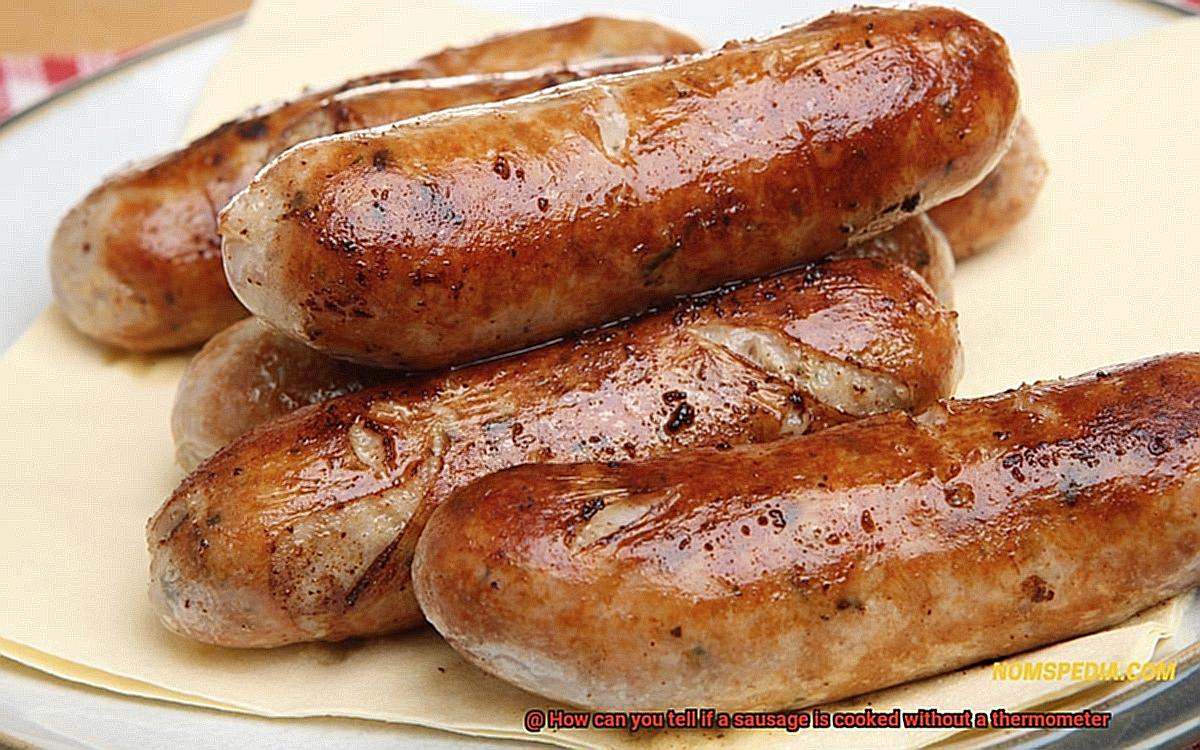
Experiment with Different Flavors
Finally, don’t be afraid to experiment with different flavors of sausages. From sweet Italian sausage to spicy chorizo, there’s a flavor out there for everyone. Try different marinades or rubs to add even more flavor to your grilled sausages.
9aBe1dXzqEQ” >
Conclusion
To cook sausages to perfection without a thermometer is a coveted skill for any home cook. While a meat thermometer is an ideal tool, there are multiple ways to check for doneness using your senses of sight, touch, and sound. By observing the color and texture of the sausage, you can determine if it’s fully cooked or not. The bounce test, twist test, and poking with a fork or toothpick are other methods that can be used to check for doneness.
It’s important to note that different types of sausages require different cooking times and techniques. For example, fresh sausages should be cooked until they turn brown or grayish, while pre-cooked smoked sausages only need heating before consumption. Cured sausages can be eaten raw or cooked until they reach an internal temperature of 160°F.
When grilling sausages, precision and accuracy are key. Piercing the sausage before grilling helps ensure even cooking while pre-cooking them before grilling reduces cooking time and prevents drying out. Keeping an eye on your sausages while grilling and letting them rest for a few minutes after removing them from the grill allows juices to redistribute throughout the sausage resulting in more flavorful bites.
In summary, by paying attention to color, texture, juiciness, and following label instructions when determining if a sausage is fully cooked without a thermometer can make you feel like a pro in the kitchen. With these tips and tricks up your sleeve, you’ll be able to cook perfect sausages every time without relying on a thermometer.

